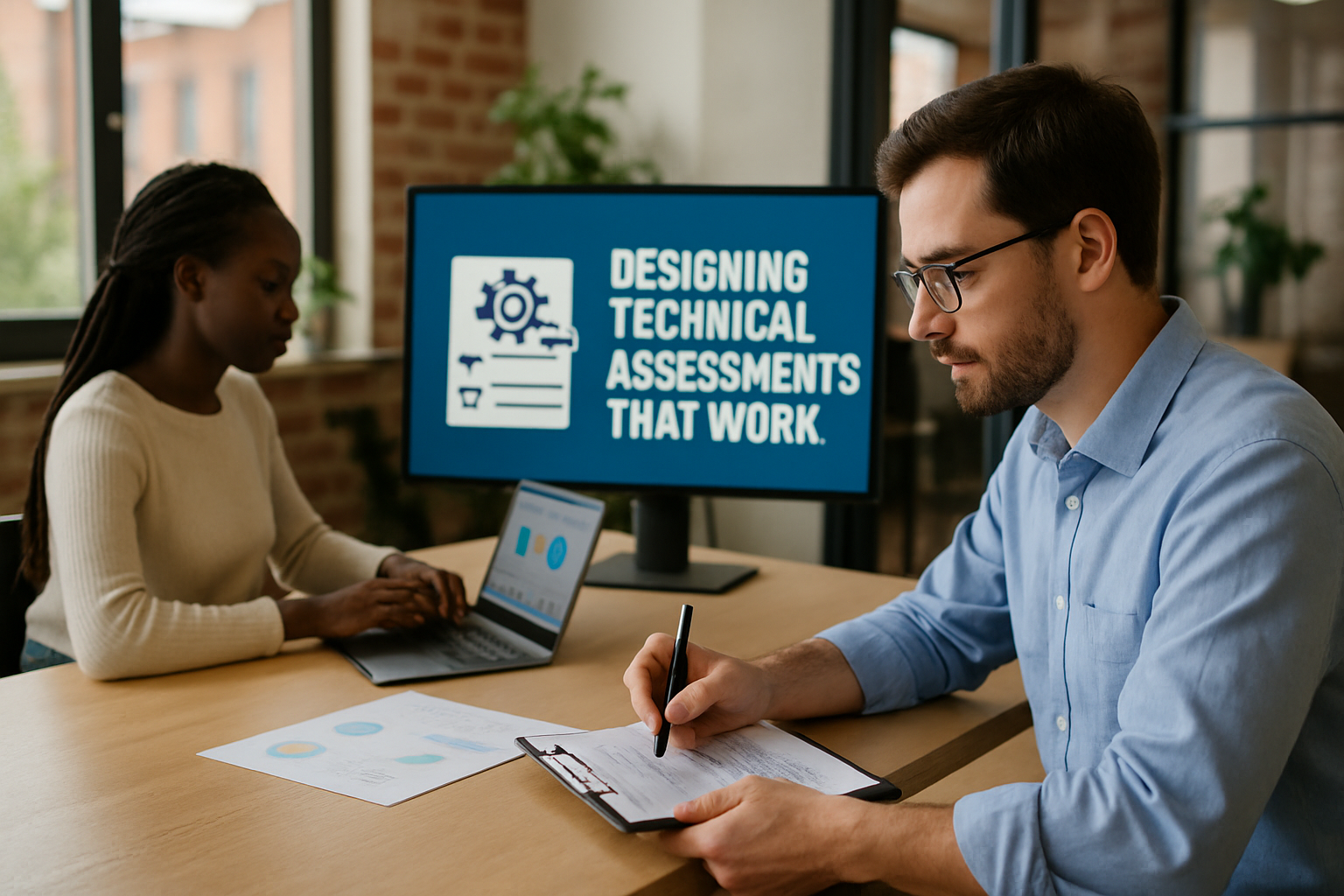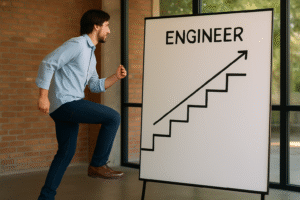
Designing technical assessments that work
Technical assessments have become an integral part of the hiring process for engineering and technology roles. They are intended to measure a candidate’s ability to solve real-world problems, write clean code, and demonstrate the skills required for success on the job. Yet, too often, technical assessments end up being barriers rather than gateways: they filter out talented, diverse candidates and fail to predict on-the-job performance. For those passionate about building inclusive, high-performing tech teams, it’s time to rethink how we design coding tests.
Understanding the Purpose of Technical Assessments
At their best, technical assessments are not just about finding the “best coder.” They should reveal how a candidate thinks, collaborates, and learns. The ultimate goal is to predict whether someone will thrive in your specific engineering environment. This requires a thoughtful balance: assessments must be fair, relevant, and as predictive of job performance as possible.
“A great technical assessment is not about who can solve the most arcane puzzle under pressure. It’s about creating an environment where candidates can show you how they approach real challenges.”
The Problem with Traditional Coding Tests
Many companies still rely on outdated coding tests that emphasize speed and obscure algorithms. This approach often benefits those with extensive competitive programming backgrounds, but it overlooks candidates with practical, real-world experience or unconventional learning journeys. For neurodivergent individuals and those with non-traditional backgrounds, these tests can be especially daunting or even exclusionary.
Common pitfalls include:
- Time-boxed algorithm challenges unconnected to daily work
- Ambiguous requirements that test guessing rather than engineering skill
- Environments lacking accessibility features or accommodations
Designing Assessments for Real-World Skills
To create technical assessments that work, start by identifying the actual tasks and skills required in the role. Speak with current team members, review recent projects, and map out the core competencies you need. From here, craft assessments that are closely aligned with daily responsibilities.
Best practices include:
- Contextual tasks: Instead of abstract puzzles, use scenarios that mirror your organization’s actual challenges. For example, ask candidates to refactor a piece of production code, debug a real system, or design an API that would be useful in your tech stack.
- Open-ended questions: Allow candidates to explain their reasoning and decision-making. This uncovers depth of understanding and communication skills.
- Collaboration elements: Engineering is rarely solo work. Consider pair programming sessions or code review simulations as part of your assessment process.
Fairness and Accessibility: Designing for Everyone
Fair technical assessments recognize that talent comes in many forms. They are accessible and inclusive, providing an equitable experience for all candidates—regardless of neurotype, gender, or background.
Some guidelines:
- Offer flexible timing: Allow candidates to complete take-home assignments at their own pace, within a reasonable window. This helps level the field for those who need more time due to cognitive or physical differences.
- Provide clear instructions: Ambiguity can disproportionately disadvantage those with ADHD or other neurodivergent profiles. State requirements, constraints, and expectations explicitly.
- Offer accommodations proactively: Make it standard to ask if candidates need extra time, breaks, or assistive technology. This removes stigma and demonstrates your commitment to inclusion.
“Fairness in assessment isn’t just a checkbox. It’s about creating opportunities for all kinds of minds to shine.”
Predictive Validity: Measuring What Matters
The best technical assessments have strong predictive validity: they accurately forecast how a candidate will perform on the job. But how do you achieve this?
Align assessments with job outcomes: Analyze what actually matters to your team’s success. Is it writing scalable code? Debugging legacy systems? Communicating complex concepts to non-technical stakeholders? Build your tests to measure these specific outcomes.
For example, if you’re hiring for a backend engineer, consider an assessment where the candidate must diagnose and fix a performance bottleneck in a sample application. If the role involves cross-functional teams, incorporate a technical communication exercise—such as writing documentation or explaining a system to a non-technical audience.
Iterative Improvement: Learning from Every Assessment
Technical assessments should not be static. Review and refine your tests regularly, using feedback from both candidates and interviewers. Analyze the data: Do strong performers on your assessment actually become strong team members? Are there patterns in who is succeeding or struggling?
- Solicit candidate feedback: Ask for honest input after each assessment. Was the test relevant, fair, and accessible?
- Correlate assessment results with job performance: Over time, track whether your assessments are predictive. If not, adjust them.
- Update for new technologies and practices: As your stack and workflows evolve, so should your assessments.
“A living, breathing assessment process enables your team to stay ahead—both in technology and in talent.”
Beyond the Code: Assessing Soft Skills and Potential
Technical excellence is crucial, but soft skills—such as communication, problem-solving, and adaptability—often make the difference between a good engineer and a great one. Incorporate assessment elements that surface these qualities.
- Code review exercises: Ask candidates to review and comment on a peer’s code, which reveals their ability to communicate constructively and think critically.
- Design discussions: Present a system design problem and invite the candidate to talk through their thought process. This can be particularly effective for identifying leadership potential.
- Emphasize learning ability: The tech landscape changes constantly. Use questions or tasks that test how candidates approach learning an unfamiliar technology.
Don’t underestimate the value of curiosity, humility, and collaborative spirit. These traits are essential for building resilient, innovative teams.
Inclusive Assessment for Women and Underrepresented Groups
Many traditional assessments unintentionally reinforce existing biases. For women and other underrepresented groups in tech, these hurdles can be particularly acute. Create a culture of belonging from the very first interaction.
Strategies include:
- Remove gendered language and stereotypes from your assessment prompts and instructions.
- Showcase diverse role models in your process—for example, by sharing stories of women and neurodivergent engineers who have succeeded on your team.
- Train interviewers to recognize unconscious bias and to evaluate candidates based on objective criteria.
Above all, communicate that you value diversity of thought and background. Candidates will notice—and respond.
The Take-Home Test: A Practical Alternative
One of the most effective formats for technical assessment is the take-home test. When designed well, this approach offers flexibility, reduces stress, and allows candidates to demonstrate their skills in a realistic setting.
Tips for effective take-home tests:
- Set clear expectations: Specify the time you expect candidates to spend (usually 2-4 hours) and make it clear that you’re interested in quality, not quantity.
- Allow for creativity: Give candidates some latitude in how they solve the problem. This reveals their unique approach and strengths.
- Provide sample data and realistic constraints: Mimic the kinds of limitations your engineers face—such as incomplete specs or legacy dependencies.
- Offer feedback: Whether or not you make an offer, let candidates know how they did. This turns your process into a growth opportunity for everyone.
“A thoughtful take-home test can turn a candidate experience into a conversation—one where both sides learn something valuable.”
Pair Programming and Live Exercises
In addition to take-home work, consider live coding sessions that mirror collaborative engineering. Pair programming, for instance, can reveal not just coding ability but also interpersonal skills, adaptability, and comfort with feedback. To make these sessions fair:
- Let candidates know in advance what the session will entail
- Allow choice of language and tools, where possible
- Focus on the process, not just the final answer
Remember that nerves are natural; frame the session as a two-way learning opportunity rather than a test.
Supporting Neurodivergent and Non-Traditional Learners
For neurodivergent candidates—such as those with autism, ADHD, dyslexia, or dyspraxia—the standard coding test may not capture their true abilities. Instead, build flexibility and understanding into your process.
Suggestions include:
- Allow for noise-cancelling headphones or quiet environments for those sensitive to sensory input
- Provide written rather than spoken instructions, or vice versa, depending on candidate preference
- Enable the use of assistive technologies such as screen readers or code linters
- Permit breaks and movement during longer assessments
Most importantly, create a dialogue with candidates. Ask what they need to perform at their best, and incorporate their feedback into your process. This isn’t just the right thing to do—it’s also the best way to unlock hidden talent.
“Tech teams that embrace every kind of mind are the ones that solve tomorrow’s problems today.”
Building a Technical Assessment Culture
Ultimately, technical assessments are not just tools for hiring. They are reflections of your team’s values, priorities, and vision for the future. When you design assessments with care, fairness, and inclusivity, you send a powerful message: We value every candidate’s potential, not just their pedigree.
Investing in better assessments takes time and thought. But the payoff—a stronger, more diverse, and more innovative team—is well worth it.
Let your technical assessments be the start of a journey, not a barrier on the path.


